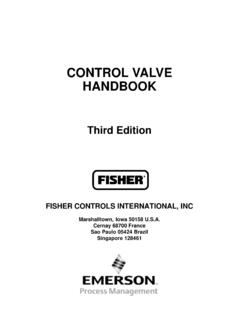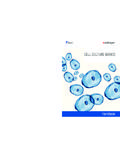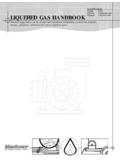Transcription of INDUCTIVE TECHNOLOGY HANDBOOK - Kaman Sensors
1 INDUCTIVE TECHNOLOGY HANDBOOK INDUCTIVE TECHNOLOGY HANDBOOK 2 P/N 860214-001 Last Revised: 08/15/12 Kaman PRECISION PRODUCTS / MEASURING A Division of Kaman Aerospace Kaman Precision Products / Measuring is a division of Kaman Aerospace Corporation. Kaman Corporation has over 60 years experience as a leader in aerospace, industrial, military, and consumer products. Kaman Precision Products / Measuring draws on over 40 years of experience with INDUCTIVE position measurement techniques to bring you the best in advanced sensor TECHNOLOGY and signal conditioning electronics. Our Location Our Sales Office is located in Colorado Springs, Colorado and our Manufacturing Facility is located in Middletown, Connecticut. We have sales representatives throughout the United States and distributors in countries around the world.
2 We can be contacted in Colorado Springs by telephone at 800-552-6267; by e-mail See our website for a current list of our representatives and distributors with their contact information INDUCTIVE TECHNOLOGY HANDBOOK 3 P/N 860214-001 Last Revised: 08/15/12 TABLE OF CONTENTS SECTION 1 - INTRODUCTION ..4 SECTION 2 - NON CONTACT MEASURING TECHNOLOGIES ..5 SECTION 3 - INDUCTIVE TECHNOLOGIES OVERVIEW ..7 BASIC INDUCTIVE COLPITTS BALANCED BRIDGE PHASE SECTION 4 - APPLYING INDUCTIVE MEASURING SYSTEMS ..16 TERMS - SECTION 5 - PERFORMANCE ..26 FREQUENCY NON APPENDIX A CALIBRATION TERMINOLOGY ..30 APPENDIX B SENSOR MOUNTING GUIDELINES ..33 APPENDIX C TYPICAL TARGET MATERIAL CHARACTERISTICS ..36 GLOSSARY ..37 QUICK CONVERSION ..39 INDUCTIVE TECHNOLOGY HANDBOOK 4 P/N 860214-001 Last Revised: 08/15/12 Section 1 - Introduction Numerous textbooks, handbooks, and assorted publications are available on sensor TECHNOLOGY .
3 These documents typically cover a broad range of Sensors and technologies, but have limited information on each type. Information on INDUCTIVE Sensors can be found in many of them. This HANDBOOK is different in that it condenses technical and application information on INDUCTIVE Sensors into a single source. The intent is to help the reader understand where INDUCTIVE Sensors can be utilized, how to best apply them, and to understand their performance. Why Kaman ? Kaman Precision Products has over 40 years of experience designing, testing, and manufacturing non contact INDUCTIVE measuring systems. We have multiple types of INDUCTIVE technologies and the applications engineering experience to help you choose the best product for your application. Custom designed measurement systems are our specialty. Standard and OEM measuring systems are available.
4 Our standard resolution is 1 part in 10,000 and we are capable of resolution up to 1 part in 100,000. Frequency response is electronics dependent and ranges from 10 KHz to 50 KHz. Sensors are capable of operating in temperatures from cryogenic to 1100 F. INDUCTIVE TECHNOLOGY is generally unaffected by contaminants such as dirt, oil, grease, water, radiation, and stray RF or magnetic fields. Worldwide network of Distributors and Sales Representatives. We are the high-end guys in the INDUCTIVE world! When you have a demanding measurement application, call your Kaman Applications s Kaman , pronounced Ca man. INDUCTIVE TECHNOLOGY HANDBOOK 5 P/N 860214-001 Last Revised: 08/15/12 Section 2 - Non Contact Measuring Technologies There are many instruments to measure position, distance, or vibration of an object.
5 These can be segregated into two basic categories: contact and non contact. Popular contact methods are: Linear Encoders, String Potentiometers, and Linear Variable Displacement Transducers (LVDTs). Some of the benefits of contact measuring systems are: long measuring range, target material insensitivity, a small spot (measuring area) size, and generally lower cost. While contact instruments are suitable for many applications, they have a limited frequency response and can interfere with the dynamics of the object being measured. Where these factors are a concern, non contact methods have advantages. Below is a list of several types of non contact measuring technologies with some of their features. Air Gauging: This technique uses air pressure and flow to measure dimensions or inspect parts. These devices operate on changes in pressure and flow rates to make a measurement.
6 A clean air supply is required. It is acceptable for use on most target materials and typically used for small measuring ranges of to inches in production environments. Hall Effect: This sensor varies its output voltage in response to changes in magnetic field. With a known magnetic field, distance can be determined. A magnetic target or attachment of a magnet to the target is required. These Sensors are generally inexpensive and are used in consumer equipment and industrial applications. They are also commonly used in automotive timing applications. Ultrasonic: Ultrasonic Sensors operate on a principle similar to sonar by interpreting echoes of sound waves reflecting off a target. A high frequency sound wave is generated by the sensor and directed toward the target. By calculating the time interval between the sent and received signals, distance to the target is determined.
7 Ultrasonic Sensors have long measuring ranges and can be used with many target materials, including liquids. Performance is affected by shape and density of the target material. They have lower resolution than most other non contact technologies and cannot work in a vacuum. Ultrasonic Sensors are frequently used to measure liquid level in tanks and in factory automation and process industries. Photonic: Photonic Sensors use glass fibers to transmit light to and from target surfaces. Displacement is determined by detecting the intensity of the reflected light. These Sensors have a very small spot size and can be used to detect small targets. They can be used with most target materials and in hostile environments. They are also insensitive to interference from EMI or high voltages. Photonic Sensors are generally used for small measuring ranges and can have high resolution and frequency response.
8 But, they are sensitive to environmental contaminants and target finish variations. INDUCTIVE TECHNOLOGY HANDBOOK 6 P/N 860214-001 Last Revised: 08/15/12 Capacitance: These Sensors work on the principal of capacitance changes between the sensor and target to determine distance. They can be used with all conductive target materials and are not sensitive to material changes. Capacitive Sensors have a relatively small spot size and are not sensitive to material thickness, but typically require a target grounded to the measuring system. They can be constructed of very high temperature materials for measurements up to 1200 oC. These Sensors have a small measuring range to sensor diameter ratio and are sensitive to environmental changes and contamination. Laser Triangulation: These Sensors work by projecting a beam of light onto the target and calculating distance by determining where the reflected light falls on a detector.
9 They can measure longer ranges than other non contact technologies; can be used with most target materials, and have a very small measuring spot size. They tend to be the most expensive type of non contact sensor. Measurement is affected by environmental contamination and surface finish variations of the target. INDUCTIVE Eddy Current: INDUCTIVE eddy current Sensors operate by generating a high frequency electro-magnetic field about the sensor coil which induces eddy currents in a target material. A conductive target is required, but a ground connection to the measuring system is not necessary. Sensor performance is affected by target material conductivity. INDUCTIVE Sensors have a large spot size in comparison to other technologies. Performance is affected by temperature changes, but not by environmental contaminants or target finish characteristics.
10 They can operate in a vacuum or in fluids. Non conductive material between the sensor and the target is not detected. The measuring distance is typically 30-50% of sensor diameter. As with any device, both contact and non contact measuring technologies have a wide range of performance characteristics ranging from very low (on-off) to very high precision (nanometer resolution), depending on their construction. It is not only necessary to choose the correct TECHNOLOGY , but also the correct level of performance for an application. INDUCTIVE TECHNOLOGY HANDBOOK 7 P/N 860214-001 Last Revised: 08/15/12 Section 3 - INDUCTIVE Technologies Overview Basic INDUCTIVE TECHNOLOGY INDUCTIVE TECHNOLOGY operates on the principle of impedance variation caused by eddy currents induced in a conductive target by a sensor coil. The sensor coil is excited by a high frequency oscillator.








